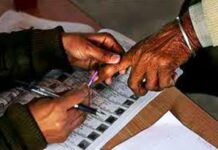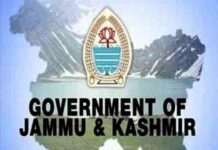
Masood Hussain
Jammu
For fiscal 2017-18, J&K government proposes to spend Rs 79472 crore of which Rs 31,000 crore (39%) is expected to be spent on developmental activities. If implemented this could be the highest ever allocation for developmental activities in a fiscal year.
Employees who run the state will cost the government 25 percent as wages and an additional six percent as pensions. The percentage spending on salary and wages in overall spending has gone down, as compared to earlier years, primarily because the capital expenditure has surged to a new level.
In the current fiscal 2016-17, the salary and pensions of the employees were jointly accounting for 36 percent of the overall expenditure.
An incidental impact of the gradual change-making is that net spend on implementing development is getting cheaper. In 2014-15, J&K was spending Rs 5.62 for every one rupee it invested in developmental activities. In the revised estimates for 2016-17, this ratio had reached Rs 2.25 that Dr Drabu estimates to take to Rs 1.59, which will be the lowest ever – historic in a way.
Increase in budgeted Capex has massively shifted the total percentage of expenditure on Development front . In 2011-12, the rate of investment was 6.80 percent of the State Domestic Product which has reached 10.02 percent in 2016-17, the highest ever.
But in Drabu’s first non-zero-deficit budget, there is a clear resource gap of Rs 3137 crore which he said would be managed through “ways and means” during the course of the year. This is despite the fact that it is revenue surplus to the tune of Rs 9300 crore.
To fund such a huge resource, the government will be making a borrowing of Rs 18000 crore, which almost doubles the 2015-16 figure. Interestingly, however, the borrowings in the current fiscal 2016-17 have been contained at a much lower level against the budgeted figure.
Interestingly 43 percent of overall resource will come in the form of central grants, 13 percent each of central grants and share in central taxes and seven percent of state’s own non-tax. The balance 24 percent will be managed through borrowings.
On the expenditure side, 39 percent goes to developmental activities, 12 percent each to ‘other expenditure’ and power purchase, 25 percent to wages and salaries, six percent each to interest payment and employee pensions.
The capital expenditure includes spending Rs 3955 crore for state sector schemes, allocation of Rs 1037 crore to district sector, Rs 10000 crore under Centrally Sponsored Schemes, Rs 8500 crore under Prime Ministers Development Programme (TAMEIR), Rs 933 crore to be devolved to PRIs and ULBs under 14th FC grants, making a provision of Rs 5000 crore on pension and leave encashment, and keeping Rs 25 crore for VRS in PSUs.
Drabu said the main focus in 2017-18 will be on timely rollout of projects under Prime Minister’s Development Package (PMDP) of Rs 80,000 crore for development and reconstruction of physical and economic infrastructure. The package caters to the need to strengthen the economic and social infrastructure and provide for the balanced development of the three regions of J&K.
Sector wise revenue expenditure suggest that Rs 19098 crore (39.12%) goes to general services, Rs 14506 crore (29.71%) goes to social services and balance Rs 14623 crore (29.95%) will go to economic services. State’s revenue expenditure is at Rs 48819 crore of which Rs 592 crore is for Ladakh. On the capital expenditure side, general services will require Rs 1954 crore (7.39%), social services sector will have a fund availability of Rs 5659 crore (21.40%) and the economic services will get Rs 18653 crore (20.01%).
The budget documents, printed for the first time with colour front pages featuring lattice design, is offering a clear indication of what happened to trade and businesses in the current fiscal. State’s trade balance continues to be negative meaning it imports more than it exports. Against a balance of Rs 25153 crore in 2014-15 and Rs 25040 crore in 2015-16, the current fiscal witnessed the trade balance touching a new low or a high – see it from the point of view you have, to Rs 14744. This was because of the situation that prevailed in Kashmir this past summer. While the exports remained unchanged, the imports nosedived from Rs 48336 crore in 2015-16 to Rs 37833 crore.
The situational impact was admitted by the Finance Minister in his speech as well. The state had a fall in its revenue receipts. The total revenue receipts of the state for the current financial year were revised to Rs 57,522 crore; lower than the anticipated budgeted estimates of Rs 4,159 crore. “This shortfall is mainly on account of lower collection of State’s own Tax Revenue and a reduced level of borrowings,” Drabu said. “Tax Revenue is expected to register a shortfall of Rs 778 crore as the non tax revenue shows an increase of about Rs 1,200 crore because the RE includes contra credit of Rs 1,400 crore on account of power subsidy. Otherwise, non tax revenues have done equally badly.”
Besides, Revenue Expenditure is about Rs 2,400 crore less than what was budgeted for, and Capital Expenditure is more or less at the budgeted level. As a consequence of this, the resource gap has increased by about a Rs. 1,000 crore. In other words, the fiscal deficit is higher than what we had budgeted for, he added. This was despite the fact that Drabu said he the government cleared liabilities of Rs 5,000 crore and hope to clear another Rs 3,000 crore more.















